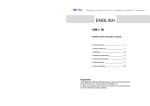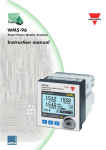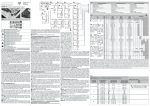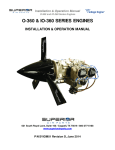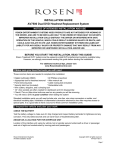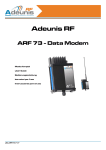Download CARLO GAVAZZI WM24-96 - PROGRAMMING User manual
Transcript
CARLO GAVAZZI A u t o m a t i o n C o m p o n e n t s WM24-96 Universal Utility Meter Contatore Universale USER MANUAL MANUALE ISTRUZIONI Modular system Tecnologia modulare CARLO GAVAZZI C o m p o n e n t s ING WM24-96: Modular Universal Utility Meter and Power Analyzer Plug and play module system; energy meters, gas and water meter. These are only a few among many other functions performed by your WM24-96. What’s more, Carlo Gavazzi means ISO9001 certification, a working experience of many decades and a widespread presence all over the world. All this because we want our customers to have the top service and the top products. A Plu TH K g YO U FO R M and od P ule lay s CH OOS Welcome in the Carlo Gavazzi world and compliments for your smart choice. Visit our website and evaluate our range of products: www.carlogavazzi.com N CARLO GAVAZZI A u t o m a t i o n 2 Index CARLO GAVAZZI WM24-96, modular universal utility meter and power analyzer FW rev. 01 TO BEGIN WITH . . . . . . . . . . . . . . . . . . . . . . . . . . . . ■ Front panel description . . . . . . . . . . . . . . . . . . ■ List and description of displayed measuring pages . . PROGRAMMING . . . . . . . . . . . . . . . . . . . . . . . . . . . ■ Access to the main menu . . . . . . . . . . . . . . . . . ■ Change password . . . . . . . . . . . . . . . . . . . . . . ■ System . . . . . . . . . . . . . . . . . . . . . . . . . . . . . . ■ CT ratio . . . . . . . . . . . . . . . . . . . . . . . . . . . . . . ■ VT ratio . . . . . . . . . . . . . . . . . . . . . . . . . . . . . . ■ Dmd calculation . . . . . . . . . . . . . . . . . . . . . . . ■ Access to the energy meters menus . . . . . . . . ❑ The functions of the Energy Meters submenu. ■ Digital outputs . . . . . . . . . . . . . . . . . . . . . . . . . ❑ Digital output 1 . . . . . . . . . . . . . . . . . . . . . ❑ Pulse digital output . . . . . . . . . . . . . . . . . . ❑ Alarm digital output . . . . . . . . . . . . . . . . . . ❑ Digital output 2 . . . . . . . . . . . . . . . . . . . . . ■ Setting of serial communication port address . . ■ Digital filter . . . . . . . . . . . . . . . . . . . . . . . . . . . . ■ End of programming . . . . . . . . . . . . . . . . . . . . ■ Reset of total gas, water, energy meters . . . . . ■ Reset of partial gas, water, energy meters . . . . ■ How to prevent key-pad programming . . . . . . . USEFUL INFORMATION . . . . . . . . . . . . . . . . . . . . . . ■ Example of how to use the digital filter . . . . . . . ■ What is ASY? . . . . . . . . . . . . . . . . . . . . . . . . . . ■ Retransmitted variables . . . . . . . . . . . . . . . . . . ■ Alarm digital output . . . . . . . . . . . . . . . . . . . . . . . . . . . . . . . . . . . . . . . . . . . . . . . . . .04 .04 .04 .09 .09 .09 .10 .10 .11 .11 .13 .13 .16 .16 .16 .18 .19 .20 .20 .21 .21 .22 .22 .23 .23 .24 .24 .25 3 ▲ ▲ Front Panel Description 4 3 Index INSTALLATION . . . . . . . . . . . . . . . . . . . . . . . ■ Operations preliminary to the installation ■ Front panel cut-out . . . . . . . . . . . . . . . . ■ Position of slots and relevant modules . . ■ Connection of optional modules . . . . . . . ■ 1-phase electrical diagrams . . . . . . . . . . ■ 3-phase electrical diagrams . . . . . . . . . . TECHNICAL FEATURES . . . . . . . . . . . . . . . . . . . . . . . . . . . . . . . . . . . . . . . . . . . . . . . . . . . . . . . . . . . . . . .26 .26 .27 .28 .31 .34 .34 .36 We suggest you to keep the original packing in case it is necessary to return the instrument to our Technical Service Department. In order to achieve the best results with your instrument, we recommend you to read this instruction manual carefully. HOW TO USE THE SYMBOLS Go to the page where the previous main subject is described. ▲ Go to the page where the next main subject is described. ▲ Go to the page where the subject written on the top of the current page starts. Go to the page where the subject written on the top of the current page ends. This symbol indicates a particularly important subject or information. This symbol indicates that more details are given on the current subject. 2 ▲ ▲ Display “tot -1 .Cn” 7 4 To begin with ■ Front Panel Description Back-lighted LCD Display. Display previous page. Display next page. Access to programming or setting confirmation. ■ List and Description of Displayed Measuring Pages When the instrument is switched on it shows the page below: PF∑ kW∑ kvar∑ ▲ Hz ▼ kW∑ PF∑ kVA∑ ▲ ▼ kW dmd kVA dmd ▼ Serial communication status: r=Rx; t=Tx (only with serial communicat. module inserted) Gas, water, en. meters pages 8 ▲ ▲ ▲ Hz 6 To begin with VL2-N VL1-N VL3-N ▲ ▼ A L2 V∑ If displayed in the measuring mode it means: the alarm is ON. An A L1 A L3 ▲ 5 ▼ W L2 W L1 W L3 ▲ ▲ Multiplyer ▼ PF L1 PF L2 PF L3 PF ∑ ▼ kvar L2 kvar L1 kvar L3 ▲ ▼ kVA L2 kVA L1 kVA L3 ▲ ▼ Index ▲ Programming 4 8 ▲ 3 9 6 To begin with The energy meter pages are different according to the setting of the instrument (see energy meter menu on pag.13). ■ If you choose “tot” the instrument displays: Generated capacitive reactive energy: integration of the sum of single phase reactive powers of quadrant 4 only. ▲ ▼ Consumed capacitive reactive energy: integration of the sum of single phase reactive powers of quadrant 2 only. ▲ ▼ Generated inductive reactive energy: integration of the sum of single phase reactive powers of quadrant 3 only. ▲ ▼ Consumed inductive reactive energy: integration of the sum of single phase reactive powers of quadrant 1 only. ▲ ▼ Generated active energy: integration of the sum of single phase negative active powers only. ▼ “tot-Prd” 4 8 ▲ ▲ ▲ 8 To begin with 7 Consumed active energy: integration of the sum of positive single phase active powers only. ▲ ▼ ■ If you choose “tot-1.Cn” the instrument displays all the pages displayed in the “tot” selection as well as: GAS meter as m3, night tariff. ▲ ▼ GAS meter as m3, day tariff. ▲ ▼ ■ If you choose “tot-2.Cn” the instrument displays all the pages displayed in the “tot” selection as well as: Total WATER meter as m3. ▲ ▼ Total GAS meter as m3. ▲ ▼ dmd calculation 4 8 ▲ 5 ▲ Measuring Pages 11 8 To begin with ■ If you choose “tot-Prd” the instrument displays: Reactive energy consumed during tariff 1: integration of the system active power only if positive (same is also for tariff 2, 3 and 4). ▲ ▼ Active energy consumed during tariff 1: integration of the system active power only if positive (same is for tariff 2, 3 and 4). ▲ ▼ Consumed total reactive energy: integration of the system reactive power only if positive. ▲ ▼ Consumed total active energy: integration of the system active power only if positive. ▲ ▼ Once the energy meter pages are finished, the instrument will display some pages related to the variables connected to the alarm. Display of alarm settings (AL1 and AL2 if both alarms have been set). It displays the variable connected to the alarm. ▲ ▼ The scrolling of the measuring pages is cyclic, at the end of the cycle, you go back to the first page (see page 4). Index ▲ System 4 ▲ 3 10 Programming 9 ■ Access to the main menu To access to the programming menus from the measuring and display phase, press the S key : when the instrument asks for the password, enter the correct PASS value S by means of the ▲ and ▼ keys; afterwards confirm by means of the S ▲ ▼ Access to the main menu S key. If the password is correct (when the instrument is new, the password is 0), the instrument goes to the main functions menu. When the “AL” box (normally used for the alarm indication) is active during the programming phase, it means that the displayed value can be modified. This rule applies to all the programming menus. ■ Change Password This function allows the operator to choose the desired password value (from 0 to 1000). Choose the “CnG.PASS” function S by means of the ▲ and ▼ keys, then press S to modify PASS, enter the desired value by means of the ▲ and ▼ keys and confirm ▲ S ▼ the new value with the S En. meters Menu 22 ▲ ▲ En. meters Display 7 key. 13 10 Programming ■ System This function allows the operator to select the electrical system choosing between three-phase with neutral (3P.n) and three-phase without neutral (3P). S Choose by means of ▲ and ▼ the “SySTEn” function, press S to enter the menu; then, select the desired system by means of the ▲ and ▼ keys and confirm with S . ▲ ▼ S ■ CT ratio S ▲ S 1.2.. ..2.1 ▼ This function allows the user to select the value of the CT ratio. Example: if the CT primary (current transformer) has a current of 300A and the secondary has a current of 5A, the CT ratio corresponds to 60 (obtained by carrying out the following calculation: 300/5). Choose the “Ct.rAtio” function by means of the ▲ and ▼ keys; to enter the menu press S ; then select the desired value by means S of the ▲ and ▼ keys and confirm the new value with S . ▲ ▼ S Synchronization 9 22 ▲ 5 ▲ Measuring Pages 12 Programming 11 ■ VT ratio S ▲ S 1.2.. ..2.1 ▼ This function allows the user to select the value of the VT ratio. Example: if the primary of the connected VT (voltage transformer) is of 20kV and the secondary is 100V, the VT ratio will correspond to 200 (obtained by carrying out the following calculation: 20000/100). Choose the “Vt.rAtio” function by means of the ▲ and ▼ keys; to enter the menu press S , then select the desired value by means S of the ▲ and ▼ keys and con- ▲ ▼ S firm it with S . By changing the VT and CT ratio, the energy meters are reset. ■ Dmd calculation This function allows the user to select the integration time of the W and VA demand value. To enter these functions select “P.int t” from S the main menu by the ▲ and ▼ keys; to enter the menu press S . Set the minutes by means of the ▲ and ▼ keys and confirm the S ▲ 1.2.. ..2.1 ▼ new value with S . Main Menu ▲ Digital Input Table 9 22 ▲ 9 15 12 Programming If, for example, you select the value “15 minutes”, the instrument calculates the demand value and updates the value every 15 minutes. See the diagram below. Where: Pc is the contractual power t1 is the selected integration period SYNCHRONIZATION OF THE POWER DEMAND CALCULATION The synchronization enables the WM24-96, by means of the digital inputs, to start the integration of the power demand at the same time as the official watthour meter. The synchronization can be carried out in two ways: - Without digital input module: the reset and the start of the energy integration are carried out when the instrument is switched on; - With the digital input module: the synch. starts when one of the digital inputs changes status (that is to say when the tariff changes). Any following change of status resets and synchronizes again the calculation of the power demand. Meters Submenu 9 22 ▲ ▲ Energy Meters Pages 7 14 Programming 13 ■ Access to the energy meters menu This function allows the user to choose the parameters for the management of the energy meters. Choose the function S “COUntEr” by means of the ▲ and ▼ keys: to confirm the value and enter the submenu press S . By means of S ▲ ▼ the ▲ and ▼ keys, it’s possible to scroll all the functions relating to the energy meters that will be described in detail below. ❑ The functions of the Energy Meters submenu. Choose the desired function by S ▼ means of the ▲ and ▼ keys, ▼ press S to confirm. It’s possible to choose the following combinations: tot: it enables the combination of total and partial meters (see page 6). tot Prd: it enables the combination of total and partial meters: tariff t1, t2, t3 and t4 are managed by the digital inputs (see page 8); ▲ S ▲ VT Ratio ▲ Retransmitt. en. Meters 9 22 ▲ 11 17 14 Programming tot 1.Cn: it enables the combination of total en. meters and day-time and nighttime GAS meters (see also “Display pages” on page 7). Press S to select “PrESCAL Cn1”, then enter by means S of the ▲ ▼ keys the weight of every pulse of the IN2 digital input of the GAS S ▲ 1.2.. ..2.1 ▼ meters and confirm with S . The same input IN2 increases alternatively the day-time and night-time GAS meters depending on the status of IN3. tot 2.Cn: it enables the combination of total energy meters and Water and Gas meters (see also “Display pages” on page 7). Press S to select “PrESCAL S ▲ Cn1” then enter by means of the ▼ keys the weight of every pulse of the IN3 digital input of the water meters, ▲ S 1.2.. ..2.1 ▼ confirm with S and go to the “PrESCAL Cn2” submenu. Enter by means of the ▲ ▼ keys the weight of every pulse of the IN2 digital input of the Gas meter, then confirm with S . ▲ S 1.2.. ..2.1 ▼ The prescaler (PrESCAL) sets the weight of the input pulses of the digital input module; e.g.: by setting the prescaler at 10, for each received pulse the meter increases by 10 (10, 20, 30, etc.). The range of the prescaler varies from 0.1 to 100.0. Main Menu ▲ Digital Outputs 9 22 ▲ 9 16 Programming 15 The increase of the Water, Gas meters, the selection of night/day tariff of the gas meters or the change of tariff (t1, t2 t3, t4) is carried out thanks to the combination of the input pulses to the AQ1038 or AQ1042 digital input module, according to the following table: SETTING RESULT DIGITAL INPUTS OF INSTRUMENT Setting “tot Prd” Display of total and partial multi-tariff energy meters. Setting “tot 1.Cn” Display of total en. meters and GAS day/night tariff. Setting “tot 2.Cn” Display of total energy meters, GAS and WATER. IN 3 IN 2 ON ON Tariff 1 OFF ON Tariff 2 ON OFF Tariff 3 OFF ON Tariff 4 Increase GAS night tariff of GAS meters GAS day tariff (*) ON OFF Increase Increase of of WATER GAS meters meters (*) (*) (*) The pulse corresponds to an increase of the various meters by the pre-set weight. If the IN 1 contact is closed (3 digital inputs module), the programming from key pad is inhibited. The synchronisation starts at the status modification of the digital inputs (IN2 and IN3) when the instrument is set to “tot” or “tot-Prd”. Digital Output 2 9 22 ▲ ▲ Energy Meters 13 19 16 Programming ■ Digital Outputs ❑ Digital Output 1 This function enables to set the parameters of the digital outputs. Choose the “diGout” function by S means of the ▲ and ▼ keys, to S enter the menu press S . Then, select one of the following options; PUL: access to the retransmission functions of the totalized energy by means of pulses (see pulse digital output); ALr: access to alarm functions (see alarm digital output); To enter S S ▲ ▼ Alarm digital output on page 18 to relevant menu press S ; rEn: enables the activation of the output by means of the serial communication. Confirm with S to enable the function. Digital output 2 on page 19 ❑ Pulse digital output Select “diGout1 PUL” by means of S the ▲ and ▼ keys: press S to enter the relevant programming submenu, then choose the meter to be retransmitted among the available ones. ▲ ▼ S Alarm Output 9 22 ▲ ▲ dmd Calculation 11 18 Programming 17 The list displaying the en. meters to be retransmitted varies depending on the chosen setting of the instrument, that is, depending on the “en. meter” selection chosen among: “tot”, “tot-Prd”, “tot1.Cn”, “tot-2.Cn”, as reported in the table below: IF IF THE SELECTION IS THE SELECTION IS tot, tot-1.Cn, tot-2.Cn: tot-Prd: kWh (consumed) kWh- (generated) kvarh ind (cons. inductive) kvarh -ind (gen. inductive) kvarh CAP (cons. capacitive) kvarh -CAP (gen. capacitive) kWh tot (total energy meter) kvarh tot (total en. meter) kWh t1 (energy meter tariff 1) kvarh t1 (energy meter tariff 1) and so on for the other tariffs t2-t3-t4. EXAMPLE OF DISPLAY Scroll the energy meters displayed by means of ▲ ▼ and choose the desired one by means of S , then the instrument displays the page where the pulses to be associated to the energy are indicated. Select the number of pulses by means of ▲ ▲ S 1.2.. ..2.1 ▼ ▼ (pulses/kWh from 1 to 100) and confirm with S . The programming continues for digital output 2. Digital output 2 on page 19 End of Programming 9 22 ▲ ▲ Digital Input Table 15 21 18 Programming ❑ Alarm Digital Output This function allows the user to set the parameters of the alarm digital output. Choose the “diGout1- ALr” function by means S of the ▲ ▲ ▼ S ▼ keys: to enter the menu press S . Then, set the following parameters: VAr: choose the variable to be associated to the alarm activation by means of the ▲ and ▼ keys ▲ S ▼ and confirm with S . rnG: choose the decimal point position. on: activation set-point, value of the variable over which the alarm is activated. Select the value of the variable by means of the ▲ and ▼ keys S ▲ 1.2.. ..2.1 S ▲ 1.2.. ..2.1 ▼ ▼ and confirm it with S ; oFF: deactivation set-point, value of the variable over which the alarm is deactivated. Select the value of the variable by means of the ▲ and ▼ keys and confirm it with S ; nd: normally de-energized output when there is no alarm. nE: normally energized output when there is no alarm. Select the output status by means of the ▲ and ▼ keys and confirm it with S ; Digital Filter 9 22 ▲ ▲ Energy Meters Menu 13 20 Programming 19 SEC: delay time from the detection of the alarm and the activation of the output. Choose the value of the delay time in seconds by means of ▲ S 1.2.. ..2.1 ▼ the ▲ and ▼ keys (up to 255 seconds) and confirm with S . Digital output 2 ❑ Digital Output 2 PUL: access to the retransmission functions of the totalized energy by means of pulses (see pulse digital output on page 16). ALr: access to alarm functions (see alarm output on page 18). To enter S the relevant menu press S ; rEn: enables the activation of the output by means of the serial communication. Confirm with enable the function. S to ▲ ▼ S 9 Useful Information 22 ▲ ▲ Retransmittable en. meters 17 23 20 Programming ■ RS422/485 Serial port address Select “AddrESS” from the main menu by means of the ▲ and ▼ S keys; to enter the menu press S , then set the desired serial address value (from 1 to 255) by means of the ▲ and ▼ keys and confirm it ▲ S 1.2.. ..2.1 ▼ with S . ■ Digital Filter Select “FiLtEr” by means of the ▲ and ▼ keys: to enter the menu press S S . Select the parameters to be set with the ▲ and ▼ keys, to enter ▲ S 1.2.. ..2.1 ▼ the menu press S . There are two parameters: - rnG, sets the operating range of the digital filter. The value is expressed as % of the full scale value: set the desired value (from 0 to 100%) by means of the ▲ and ▼ keys and ▲ S 1.2.. ..2.1 ▼ confirm it with S ; - Coe, sets the filtering coefficient of the instantaneous measurements. Set the desired value (from 1 to 16) by means of the ▲ and ▼ keys and confirm it with S . By increasing the value both the stability and the settling time of the measurements are increased. See also “Example 2” in Useful Information on page 23. Meters Reset 9 22 ▲ ▲ Meters Increase 15 22 Programming 21 ■ End of programming To exit from programming and go back to the measuring mode, select “End” from the main menu by means S of the ▼ and ▲ keys, confirm it Measuring Instrument mode revision with S . ■ Reset of total meters Select “rESEt tot” from main menu by means of the ▲ S S ▼ keys, S . When the then confirm with instrument asks for the reset, choose, by means of the ▲ ▼ keys: “no” to avoid the reset or “yes” to confirm it. Then, press S to carry out the command. ▲ ▼ S RESET Up/Down Alarm 9 22 ▲ ▲ Digital Output 2 19 25 22 Programming ■ Reset of partial meters Select “rESEt Prt” from the main menu by means of the ▲ S ▼ keys, then confirm with S . When the instrument asks for the reset, choose, by means of the ▲ ▼ keys: “no” to avoid the reset or “yes” to confirm it. Then, press S to carry out the command. ▲ S RESET ■ How to prevent the programming by key-pad It is possible to prevent any access to programming by modifying the switch in the power supply slot (see the drawing on the left), or closing the contact N 1 of the digital input module if present. Turn the switch using a little screwdriver. - Free programming. - Lock programming. 10 What is ASY ▲ ▲ Retransmittable meters 17 24 Useful Information 23 The variables measured by the instrument are correct if the polarities of the inputs have been observed (as shown in the figure below); if not, measuring and retransmission errors may occur due to the wrong direction of the current flowing in the primary / secondary of the connected current transformer. Example 2 “Use of digital filter”: it’s necessary to stabilize the displayed value of the VL1-N variable that varies between 222V and 228V. The parameters of the digital filter are to be set as follows: • rnG: the variable varies within the average value, the amplitude of which is equal to ±1.3% of the variable’s rated value, calculated as follows: (228-222)/2=±3V, then ±3*100/231V=±1.3%, where 231V is the phase-neutral rated value of a 400V input range. The “range” parameter, that corresponds to the action range of the digital filter, is set at a value which is slightly higher than the percentage amplitude of the fluctuation: e.g. 2%. • CoE: if the new value acquired by the instrument is within the filter’s action range, then the new displayed value is calculated by summing algebraically to the previous value the variation divided by the filtering coefficient. As a consequence, a value which is higher than this coefficient implies a longer settling time and therefore improves the stability. The latter can also be improved by increasing the filtering coefficient: the admitted values are within 1 and 16. Enter the value in consecutive attempts until you reach the desired stability. Dimensions 25 ▲ ▲ End of Programming 21 27 24 Useful Information ■ What is ASY The ASY variable allows the user to control the symmetry of the delta voltages (for systems without neutral) and star voltages (for systems with neutral). The variable is calculated according to the following formula: ASY= Where: Vmax - Vmin Vavg *100 Vmax is the max. value among VL1-N, VL2-N, VL3-N Vmin is the min. value among VL1-N, VL2-N, VL3-N Vavg is the average: (VL1-N, VL2-N, VL3-N)/3 The variable is not displayed by the instrument, but can be retransmitted by the analogue or RS422 / 485 output and can be controlled by means of the alarm. ■ Retransmitted variables N° Variable 3-ph with 3-ph withNotes neutral out neutral V L-NΣ x Σ = system V L-LΣ x x Σ = system WΣ x x Σ = system varΣ x x Σ = system VAΣ x x Σ = system PFΣ x x Σ = system PF x x VA dmd x x W dmd x x ASY x x asymmetry The energy meters as per table on page 17 All instantaneous variables (powers, currents, voltages) 1 2 3 4 5 6 7 8 9 10 11 12 Installation 23 25 ▲ ▲ Digital Output 2 19 26 Useful Information 25 ■ Alarm digital output The activation of the alarm can be up or down depending on how the ON and OFF parameters have been set, as per the following table: ON-OFF VALUES STATUS ALARM TYPE ON ≥ OFF UP ON < OFF DOWN ■ Displaying of programming menu It may be useful to know that the menus displayed by the instrument depend on its configuration; e.g.: the instrument will not display the menu relevant to the digital outputs if the optional module is not inserted. It is important that the instrument is switched off when you plug-in or disconnect the modules. 23 Available Modules ▲ ▲ E.g.: Use of Digital Filter 23 29 26 Installation ■ Preliminary operations Before switching the instrument on, make sure that the power supply voltage corresponds to what is shown on the side label of the relevant module. ■ Before mounting the modules To know in which slot every module is to be mounted, refer to the figure on page 28. For a correct mounting of the instrument, insert the modules in the relevant slots, then, at the end, enter the central module, which can be a blind type module or an RS232 communication module. The central module will help fixing also the other modules in the relevant slots. To remove the modules use a screwdriver as shown in the picture below. 1 Gently depress the two fixing tabs. Directions 1-4. 2 Remove the central module from its slot: press your thumb towards points 2-5. Extract the central module. 3 Any other slots that are not used must be filled with the relevant blind plug modules supplied with the instrument. Position of Slot 35 ▲ ▲ End of Programming 21 28 27 Installation ■ Overall dimensions and panel cut-out ❑ Mounting Insert the instrument (holding its front) and fasten it (from the back) by fixing the two lateral brackets (1) (supplied with the instrument) to the appropriate location (2), using the two screws (3) supplied with the instrument. 2 1 3 Optional Modules conn. 26 35 ▲ ▲ Up/Down Alarm 25 31 28 Installation ■ Position of the slots and relevant modules B A D C PU IM PS ■ Available modules ❑ Relay digital output modules AO1035 Dual relay output AO1058 Single relay output 26 Optional Modules 35 ▲ ▲ E.g.: Use of Digital Filter 23 30 29 Installation DESCRIPTION A B C D PU PS IM ✓ RS485/RS422 serial port ✓ RS232 serial port Single relay output ✓ ✓ Single open collector output ✓ ✓ Dual relay output ✓ ✓ Dual open coll. output ✓ ✓ 3 digital inputs ✓ 3 digital inputs +AUX ✓ ✓ Power supply ✓ Measuring inputs ❑ Open collector digital output modules AO1059 Single open collector output AO1036 Dual open collector output Mounting ▲ Serial connection 26 35 ▲ 27 33 30 Installation ❑ Digital input modules AQ1038 3 digital inputs AQ1042 3 digital inputs + aux ❑ Serial port modules AR1039 RS232 serial port AR1034 RS485/422 serial port ❑ Power supply modules AP1025 24VAC Power supply AP1024 48VAC Power supply AP1023 115VAC Power supply AP1022 AP1020 90-260 VAC/DC Power supply 230VAC Power supply AP1021 18-60VAC/DC Power supply Relay Output conn. 26 35 ▲ ▲ Up/down Alarm 25 32 Installation 31 ■ Optional module connections ❑ Digital inputs Connection by NPN transistor. AQ1042 Digital input module. Connection by PNP transistor. AQ1042 Digital input module. Connection by contacts. AQ1042 Digital input module. Connection by contacts. AQ1038 Digital input module. 3-ph 3-wire connection 26 35 ▲ ▲ Modules Position 29 35 32 Installation ❑ Relay output AO1058 Single relay output AO1035 Dual relay output ❑ Open collector output This diagram is valid also for the single output open collector module. The value of the load resistances (Rc) must be chosen so that the shortcircuit current is lower than 100mA; the VDC voltage must be lower than or equal to 30 VDC. AO1059 Single open collector output AO1036 Dual open collector output Dimensions ▲ Electrical diagrams 26 35 ▲ 27 34 Installation 33 ❑ RS485/422 (AR1034) serial port 4-wire connection. Additional devices provided with RS485/RS422 (that is RS 1,2,3...N) are connected in parallel. 2-wire connection. Additional devices provided with RS485/RS422 (that is RS 1, 2, 3 ...N) are connected in parallel. The termination of the serial output is carried out only on the last instrument of the network, by means of a jumper between (Rx+) and (T). We recommend you to use the 4-wire connection: by means of the serial port the data are exchanged faster. Technical features 26 35 ▲ ▲ Digital Input Conn. 31 37 34 Installation ■ Electrical diagrams ❑ Single-phase connection I 1 3 5 L1 L2 L3 2 4 6 8 L1 7 N 10 L3 L2 9 U I CT connection 1 3 5 L1 L2 L3 2 4 6 8 L1 7 N 10 L3 L2 9 U L1 L1 N N CT and VT connections ❑ Three-phase, 4-wire, unbalanced load CT connection (4-wire system) CT and VT connections (4-wire system) Accuracy 26 35 ▲ ▲ Available Modules 29 36 Installation CT and VT connections (3-wire system) 35 3 CT and 3 VT connections (3-wire system) ❑ ARON connection, 3-phase, 3-wire, unbalanced load CT connection (3-wire system) ARON CT and VT connections (3-wire system) ARON Technical Features 26 ▲ ▲ Serial Connection 33 39 36 Technical Features ■ Number of inputs Current: 3; Voltage: 4 ■ Accuracy (display, RS232, RS485) In=5A; Pn= In* Un Current: 0.003Ib to 0.2Ib: ±(0.5% rdg + 3DGT); 0.2Ib to Imax: ±(0.5 rdg + 1DGT); Phase-neutral voltage: Un range: ±(0.5% rdg + 1DGT) Frequency: ±0.1% Hz Active power/energy: class 1 according to EN61036 Reactive power/energy: class 2 according to EN61268 Apparent power/energy: ±(1% Pn+2dgt), (@25°C ±5°C, R.H. ≤60%) ■ Temperature drift ≤ 200ppm/°C ■ Display refresh time 700ms ■ Display Back-lighted LCD 70 x 38mm 1 4x3 /2 dgt: instantaneous variables; 1 1x7 /2 dgt: energy meters. ■ Measurements Current, voltage, power, power factor, frequency, energies. TRMS measurements of distorted waves. Coupling type: direct. ■ Input impedance 208VLL 400VLL 100VLL 660VLL 5(6)AAC 5(6)AAC 5(6)AAC 5(6)AAC (AV4): (AV5): (AV6): (AV7): >200 >900 >200 >900 kΩ kΩ kΩ kΩ (phase-neutral) (phase-neutral) (phase-neutral) (phase-neutral) ■ Input/Output modules technical features RS422/RS485 (on request) Multidrop bidirectional (static and dynamic variables) Digital Inputs 40 ▲ ▲ Digital Inputs Connection 31 38 Technical Features 37 Connections: 2 or 4 wires, max. distance 1200m, termination directly on the instruments. Addresses: from 1 to 255, selectable by key-pad Protocol: MODBUS/JBUS (RTU) Data (bidirectional) Dynamic (reading only) System and phase variables: see “display pages” on page 41 All configuration parameters, activation of the static output. Data format: 1 start bit, 8-data bit, no parity,1 stop bit. Baud-rate: 9600. Insulation: By means of optocouplers, 4000 VRMS between output and measuring input, 4000 VRMS between output and power supply input. RS232 (optional) Bidirectional (static and dynamic variables) Connections: 3 wires, max. distance: 15m. Data format: 1 start bit, 8 data bit, no parity, 1 stop bit. Baud-rate: 9600 bauds. Protocol: MODBUS (JBUS) Other features: as per RS422/485 Pulse outputs (optional) Number of outputs: Up to 2 Type: from 1 to 100 programmable pulses VON 1.2 VDC/ max. 100 mA. VOFF 30 VDC max. The outputs can be connected to total and/or partial en. meters. Pulse duration: ON=220 ms, OFF≥ 220 ms according to DIN43864 Insulation: By means of opto-couplers, 4000 VRMS between output and measuring input, 4000 VRMS between output and power supply input. Notes: outputs can be open collector or relay type (for the relay output refer to the technical features described in the alarms). 36 40 ▲ ▲ Electrical diagrams 35 38 Technical Features Alarm outputs (optional) Number of outputs: up to 2, independent Alarm type: up or down alarm, phase asymmetry Control on the variables: All variables listed in the paragraph “retransmitted variables” on page 24 can be controlled. Alarm set-point: can be modified from 0 to 100% of the displayed electrical scale. Hysteresis: From 0 to 100% of the displayed scale On-time delay: from 0 to 255 sec Relay status: selectable, normally disabled or normally enabled. Output type: Relay, SPDT AC 1-8A, 250VAC; DC 12-5A, 24VDC; AC 15-2.5A, 250VAC; DC 13-2.5A, 24VDC Min. response time: ≤ 150 ms, filters excluded, FFT excluded, on-time delay: ”0” Insulation: 4000 VRMS between output and measuring input, 4000 VRMS between output and power supply input. Notes: Outputs can be open collector type or relay type (for the open collector type refer to the technical features described in the pulse outputs). Digital inputs AQ 1038: N. of inputs: 3 (free-of-voltage) Reading voltage: 24VDC/1mA AQ1042: N. of inputs: 3 + power supply inputs Power supply inputs: output voltage: 16V<+Aux<24VDC; output current: Max 15mA. Input frequency: Max 20Hz, duty cycle 50% Close contact resistance: Max 1kΩ Open contact resistance: Min 100kΩ Insulation: 4000VRMS Use of contact 1: lock of the programming from key-pad (when the contact is closed). General Specifications 36 40 ▲ ▲ Electrical diagrams 33 40 Technical Features 39 Contacts 2-3: to be used in one of the following ways: • tariff selection (t1-t2-t3-t4) and synchronization; • total meters for day-night GAS tariffs; • total GAS and WATER meters ; ■ Software functions Password: Numerical code of 4 dgts; 2 protection levels of the programming data 1st level: Password “0”, no protection 2nd level: Password from 1 to 1000, all data are protected Transformer ratio: CT from 1 to 5000 VT from 1.0 to 1999, with CT x VT ≤10000 max Power dmd: Integration time programmable from 1 to 30 min Filter: operating range: from 0 to 100% of the electrical input scale Filtering coefficient: 1 to 16 Filtering action: measurements, alarms, serial output Display: up to 4 variables per page, 3-phase system with neutral: Page 1: V L1, V L2, V L3, V LN∑ Page 2: AL1, AL2, AL2 Page 3: W L1, W L2, W L3 Page 4: VA L1, VA L2, VA L3 Page 5: var L1, var L2, var L3 Page 6: PF L1, PF L2, PF L3, PF ∑ Page 7: W ∑, var ∑, PF ∑, Hz Page 8: W ∑, VA ∑, PF ∑, Hz Page 9: W dmd, VA dmd Counter pages depending on the instruments setting: Wh+ tot, Wh- tot, Wh tot, varh tot, varh L+ tot, varh L-, varh C+, varh C-, m3 day GAS, m3 night GAS, m3 GAS, m3 WATER, Wh t1, Wh t2, Wht 3, Wht4, varht1, varht2, varht3, varht4. 36 40 ▲ ▲ Pulse outputs 37 40 Technical features ■ Power supply specifications 90 to 260 VDC/VAC;18 to 60VDC/VAC; 24 VAC -15%+10% 50-60Hz; 48 VAC -15%+10% 50-60Hz; 115VAC -15%+10% 50-60Hz; 230 VAC -15%+10% 50-60Hz ■ General features Operating temperature: 0 to +50°C (32 to 122°F) (H.R. < 90% non condensing) Storage temperature: -10 to +60°C (14 to 140°F) (HR. < 90% non-condensing) Installation category: Cat. III (IEC 664) Key-pad lock: by means of switch placed behind the display or by means of contact (if module 3 - input contacts is present). Insulation: 4000 VRMS between inputs/outputs and ground Dielectric strength: 4000 VRMS for 1 minute ■ EMC Emissions: EN50082-1 (class A) residential, commercial and light industry environment. Immunity: EN 61000-6-2 (class A) industrial environment. ■ Other standards Safety: IEC 61010-1, EN 61010-1 Product: IEC 60688-1, EN 60688-1 Approvals: CE 5(6)A connections: screw-type, max. section 2.5 mm2 (2 x 1.5mm2) Housing: Dimensions: 96x96x140 mm Material: ABS, NORYL, PC (front); self-extinguishing: UL 94 V-0 Protection degree: Front: IP65 Connections: IP20 Weight: approx. 400 g (packing included) 36 ▲ ▲ Electrical diagrams 35 Carlo Gavazzi GmbH Wien - AUSTRIA Carlo Gavazzi Automation Sdn Bhd Petaling Jaya, Selangor - MALAYSIA Carlo Gavazzi NV/SA Vilvoorde - BELGIUM Carlo Gavazzi BV Beverwijk - NETHERLANDS Carlo Gavazzi Inc. Mississauga, ON - CANADA Montreal, PQ - CANADA Carlo Gavazzi AS Porsgrunn - NORWAY Carlo Gavazzi Handel A/S Hadsten - DENMARK Carlo Gavazzi OY AB Helsinki - FINLAND Carlo Gavazzi Lda Lisboa - PORTUGAL Carlo Gavazzi SA Leioa (Bizkaia) - SPAIN Carlo Gavazzi Sarl Roissy - FRANCE Carlo Gavazzi AB Karlstad - SWEDEN Carlo Gavazzi GmbH Weiterstadt - GERMANY Carlo Gavazzi AG Steinhausen - SWITZERLAND Carlo Gavazzi UK Ltd Aldershot - GREAT BRITAIN Carlo Gavazzi Inc. Buffalo Grove IL - USA Carlo Gavazzi SpA Lainate (MI) - ITALY WM24 ita-eng code 8020593 02/2003 OUR SALES NETWORK OUR PRODUCTION SITES Carlo Gavazzi Industri A/S Hadsten - DENMARK Carlo Gavazzi Ltd Zejtun - MALTA Carlo Gavazzi Controls SpA Belluno - ITALY SAIET Elettronica SpA Castel Maggiore (BO) - ITALY Inductive and Capacitive Proximity Sensors in full metal and plastic housings. Photoelectric Sensors. Level Sensors: Optical, Conductive and Capacitive. Ultrasonic Sensors and Magnetic Switches. Limit Switches. Solid States Relays. Versions for PCB and panel mounting. AC Semiconductor Motor Controllers Soft starters. Industrial and PCB Relays. Energy Management. Timers and Monitoring Relays. Digital Panel Meters and Temperature Controllers. Safety and Magnetic Switches, Safety Modules. Mat Systems, Light Curtains, Electrical Transient, Protections. Measuring Systems and Encoders. Further information on Dupline Field and Installation Bus. Building Automation Systems. CARLO GAVAZZI A u t o m a t i o n C o m p o n e n t s www.carlogavazzi.com











































